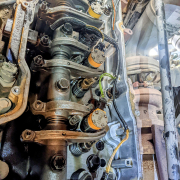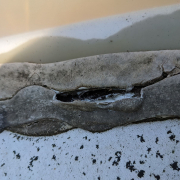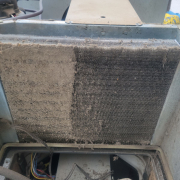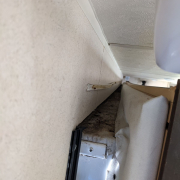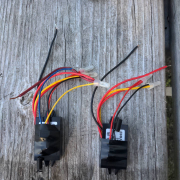CHECKLISTS: Love Them or Hate Them, They’re Your Last Best Defense
Today I’ve decided to write about something that constantly becomes a conversation with our beloved clients. I’m going to break this down into a few sections because it might be a bit long, and if reading it in one chunk isn’t practical, I hope you’ll at least come back a few times and take in the whole thing. Time is at a premium right now and I’m sacrificing some to write this because it’s important, in some situations, even life-saving important!
Background
Once upon a time, long (LONG) ago, when I was a young man, I had an incredibly agile, organized memory. When a task was at hand, the steps of the task magically arranged themselves on a sort of special blackboard in my head. As I performed the steps, they would also magically, and very securely, be wiped from the board. I never missed a step. If there were contingencies or variations required, the blackboard just rearranged itself and on I went relentlessly towards completion.
This ability/habit was actually quite a bother in flight training, where checklists often mean the difference between life and death. Although I was a natural at “stick and rudder work”, chartography, radio communications, the physics of flight, and even immune to motion sickness, the use of a physical checklist turned out to be my biggest weakness. I had absolute trust for my friend and flight instructor, so I committed to making it happen.
Then, one day, he proved to me it was necessary. As we were doing a preflight inspection, he noticed I wasn’t using the flip pad of all the plane’s various checklists. He set me up by “discovering” a potential issue with one of the landing gear tires, then led me away from the next item on the checklist by jumping in and covering a few things to “make up for lost time”. As we settled into the cockpit and I reached for the ignition key, he asked, “Did you take the sock off the Pitot tube?” He had me. The consequence would be no airspeed indication and it wouldn’t have been obvious until our takeoff roll. Since the flight characteristics of a plane are very dependent on airspeed, having no indicator is inherently dangerous.
Flash forward to the RV arena a few (OK, OK, more than a few) years later. I knew from the beginning that working with the heavy equipment of a 10,000 lb. truck and a 17,000 lb. fifth wheel camper was dangerous business. I had already seen others have accidents both small and large. I paid careful attention to how various situations had unfolded to avoid them myself. When it was time to start hitching that monster camper to my monster truck, my first move was to make a checklist.
One checklist grew to many checklists for different phases of our travels. Eventually Michelle discovered Changing Lanes on YouTube and we adopted their division of checklists into activities that can happen at “T-24”, “T-12”, and “T-0” (think T minus hours to take-off). We eventually expanded on that idea and our lists are now a comprehensive suite of both necessities and conveniences that we just don’t have to think about (or stress about) as we ramp up to one of our frequent drive days.
The Objections
I’m going to stop right here to acknowledge the nay-sayers. As I said above, checklists can seem like a bother and, under normal circumstances, add a layer of “busy work” to a task. Complaints we’ve heard are:
- I don’t need a checklist because it’s like second nature at this point.
- Checklists are for newbies.
- Checklists make things take longer and I could be using my time more wisely.
- If I needed a checklist to go camping, I shouldn’t be camping in the first place.
- My mind is sharp as a tack. I never forget anything.
- Checklists are too tedious.
There are many variations on the above, but you get the picture and may have even used some of these yourself. As I said in the Background section above, SO DID I during flight training.
The Reality
It’s not that any of the objections are incorrect in perfect conditions, it’s that the real purpose of a checklist is to ensure a consistent, and often safer process when conditions are not perfect. Aside from the truism that life isn’t perfect, here are some ways we’ve personally experienced and witnessed imperfection around breaking camp:
- The Chatty Neighbor (or Relative): This one is almost an absolute in campground environments. You’ve lowered the hitch onto the ball, but before you retract the tongue jack, it’s time for heart-felt goodbyes. Afterwards, it’s time to get things back on track and next up is a bent tongue jack because raising it was missed in the shuffle. Or an abandoned water filter hanging from the campground hose bib. Or a bent slide because someone forgot to move the camp chairs. Or whatever.
- Bad Weather: This one includes not only rain, but also excessive heat, dust storms, and even hurricane evacuation orders. Bad weather makes everything rushed, and in a rush, things can get missed.
- A Cry for Help: Nothing will break one’s stride as fast as a call for help from a spouse or child. In most cases, an interruption ranges from mildly annoying (Bobby won’t stop pulling Susie’s pigtails) all the way to mind wiping (the wife fell off the stairs and at first it seemed her ankle was broken).
- The Bump on Your Head: You raise up into a slide with your noggin or drop a hammer on your foot and suddenly there’s a certain clearing of the mind that would make a monk jealous. However, are you sure you unplugged the power cord from the pedestal?
- The Unexpected: You’re happily about your normal routine when something goes wrong. Let’s say as you’re pulling your wheel chocks, you notice some uneven tread wear on your tires. When you’re done making a plan to deal with that, did you remember to raise your stabilizers?
- The Ringing Phone: No explanation necessary for this one, but I will say in my case, I think my mother has a spy network.
- The Last Hurrah: You made such good friends on this trip, the campfire was EPIC. It also lasted half the night and you woke up with a dehydration headache from the tequila shots that were going around. This is not a good time to “trust yourself”. (NOTE: If you wake up really hung over, consider you may still have alcohol in your system and must CANCEL your travel day. Punctuality is not worth your life… or a DUI.)
- To Be Human Is to Be Distracted: As with many of the specific examples above, sometimes we just have “things on our mind”. I think the most distracted year of my life was after my oldest brother and father both died within 36 hours 2000 miles away from each other. I didn’t even realize how distracted until the checklists showed me.
- My Perfect Memory Failed Me: It happens more often than any of us want to admit. The fact is, when new information comes in, old information has to either get shuffled or dumped to make room after a certain age. Denile isn’t just a river in Egypt, as they say.
Our Ever-Evolving Checklists
Our checklists have really evolved over time. At first glance, it wouldn’t be unreasonable to call them out of control, but here’s how it all unfolded. At first, as mentioned, the most critical (dangerous) part of our camping experience was the only checklist: hitching up our giant fifth wheel camper. Also as mentioned, we came across the idea of spreading out the process of breaking camp to take things at a little easier pace. We took the Changing Lanes checklists and made them our own.
Then we did a few long stays requiring considerable efforts to get packed up to leave, which prompted us to even make a checklist of things we could do two days before departure. We knew we wouldn’t use that list all the time, so it actually duplicates items on our T-24 (day before) checklist. That led to doubling up on some other items on the other lists because sometimes we’re really busy the day before and we want to save items for the day of travel we’d normally do the day before. It’s really no big deal to tick it off more than one list and then we’re extra certain it got done.
Somewhere in the evolution, we realized that some things were just more convenient if we did them in a certain order. A really good example of this is remembering to turn on the propane before the slides come out since our propane hatch is under a deep slide. It’s not just your checklists that evolve because your camping gear changes over time too. With that can come new things to do. One of my favorite upgrades was this step stabilizer for our motorhome power steps. The downside is if we turn the key on with the door closed, the stairs try to retract and if the stabilizer is down, that’s a big problem. Checklist update to the rescue!
What’s In It for You?
So, quick recap here of all the things implied so far. Checklists are the way to:
- Increase safety
- Increase confidence
- Decrease stress
- Guard against the unexpected
- Create convenience
- Hone your process
I don’t think anyone can honestly say they don’t want that list of benefits. Some might say they don’t think the cost is worth the benefits. The problem with that view is either too much reliance on luck, or a lack of experience with the real-world cost of NOT having these benefits. Most nay-sayers are just one avoidable disaster away from being checklist enthusiasts.
Having the Checklists at Hand
Using a checklist is such a simple concept, there’s no need to explain that part. The interesting part can be getting access to the list. Here are some ways we’ve seen checklists presented for use:
- Permanent Lists: This is more or less the way you’d do checklists in a small plane. There’s a hard list, printed or written, where items don’t actually get checked off, they just get listed and it’s up to you know if you did them “this time” or not. We’re not crazy about this method, because repetition can play tricks on the mind. Did you do it this time, or was that last time? Having something as simple as a tick mark can prevent a costly and/or dangerous mistake.
- Hard Copy Disposable Lists: This way is very old school, but also very straight forward. It generally requires a printer to get that hard copy, but then at least there’s a place to clearly mark an item complete. The downside is if these are printed in advance, it might make one hesitant to revise the checklist. The ability to easily evolve is pretty important, but again, if this is the maximum tech level you can achieve, it’s 1000 times better than nothing.
- Erasable Notebooks: In addition to old school notepads you can use with a pencil and eraser, there are notepads out there now with erasable ink. You’d have to hand write the checklist, but you could still have super-simple, the ability to tick items off the list, and reusability. It wouldn’t be great for revisions, but still 1000 better than nothing.
- Tokens: An interesting way to keep up with tasks is to write them on slap bracelets and put them on the steering wheel. When something is done, you remove that slap bracelet. You can see how Today Is Someday does that on YouTube. Other variations on the same theme include magnets on a fridge and painted rocks in boxes.
- Smartphone Apps: There are many smartphone apps that can track a to do list. Some are even better at checklists. Although we’ve even seen a few RV-specific checklist apps, we currently use Google Keep, available on Android, iPhone, and webpage so you can truly run it on just about anything. It has the advantage of being able to share a list and more than one person can actually edit the list or check items off at the same time. It also has the ability to uncheck an entire list to start over with a couple of taps. It’s so easy to change our process for both of us at the same time, we are never afraid to have an idea and just throw it into the list. If we don’t like it, we can always change it later.
Our Lists
These are our lists, unabridged, judge as you may. We love them. We depend on them. We wouldn’t have lasted this long on the road without them. They have saved us time, money, and best of all, our health. You can copy and paste these lists into Google Keep by selecting all the lines of a particular list and simply pasting it on a line in Keep. It’ll make entries for each line when you “Turn on Checkmarks”.
T-48 (Two Days Before Travel)
Wash rugs, tire covers, etc?
Check fluid bus
Check fluid toad
Check Roadtrippers
Check/Empty Berkey Status
Locate cooling towels
Secure printer
Make bread
Clean Bathroom
Take camper picture
Clean Kitchen
Check reciprocity
Download all media
Clean toaster and stow
Plan fuel stop and route
Purchase supplies – creamer, sandwich etc
Fix Steve’s pills
Clean grill and stow
Put sunpass in camper
Clean Instant Pot and stow
Locate cash for tolls
Confirm funds in OpenRoads Fuel account
T-24 (The Day Before Travel)
Program ham repeaters
Clean wiper blades
Charge Doosl
Condition camper bra?
Check fluid bus
Check fluid toad
Check Berkey Status
Locate cooling towels
Clean steering wheel
Do you need to make bread?
Clean bathroom
Take camper picture
Take showers
Clean kitchen
Secure printer
Clean windshield
Check reciprocity
Verify grey tank closed!
Update Apps on phone
Update tech locator
If it’s going to rain, sweep roof, rainex rear camera
Update GPS maps
Make snackle boxes
Sweep/mop kitchen
Check hot water tank
Check toad tires (inflation, general inspection)
Download all media from dash cam and wipe
Clean toaster and stow
Plan fuel stop
Dump tanks if early departure
Return items to their spots
Fill fresh water if boondocking
Purchase sandwich supplies
Prepare travel day dinner
Check Silicone
Check back of refrigerator
Check and Condition Slides
Prepare travel day breakfast
Plan route and fuel (get a feel on gas station locations, rest stops, etc)
Fix Steve’s pills
Laundry
Stow tire covers
Wash camper nose
Turn on TPMS – check pressure
Check engine bay for hitchhikers
Confirm funds in OpenRoads fuel account
Check escape hatch
Put Sunpass in camper
Clean Mirrors
Prune Pikmin Postcards
Check Roadtrippers
T-12 (The Evening Before Travel)
Turn off night light
Make travel breakfast and put in fridge
If boondocking turn charge controllers up
Take down thermometer inside and out
Steve arm brace
Stow Berkey
Get Michelle’s sunglasses
Pack water for Steve
Is Bra secured
Clean Hydraulics
Lock big drawers
Turn off media drive
Steve’s sunglasses
Pack sandwiches/snackle boxes
Check engine bay for hitchhikers
Plug in TPMS repeater
Sweep roof, Rainex rear camera
Show Steve the route and approaches
Awnings in
Bungee rocking chair
Bungee freezer
Take Doodle for a walk
Turn off or on critter lights
Bungee spice rack
Take trash to dumpster
Slides: one last check for obstacles inside and out and basement also
Check slides for water if needed put out postit note
Bedroom A/C and lights off
Stow antennas, Dishy
Locate cash for tolls
Put Sunpass in camper
Bedroom secure (closet door latched)
Clean Instant Pot and stow
Locate walkie talkies put on driver’s seat
Locate all remotes and stow them
Vacuum/Sweep
Bedroom windows closed
Clean windshield inside
Clean windshield outside – Steve
Control Panel Items off (AC, water pump, water heater, ALL Lights)
Bathroom shower secure (everything off shelves, shower door closed, shower head
down)
Secure Toilet Area
Bathroom secure
Move doodles box
Stow computer desks
Living room secure – move rugs to center
Doodle’s food and water bowls put up front
Stow coffee cups
Stow Coffee Pot
Stow any items on counters
Arrange fridge for travel reset thermometers – latch fridge door
Bedroom door secured
Move living room chairs
Turn off propane
Fill fresh tank (% based on next location)
Kitchen secure
Windows closed / blinds up
Pantry door closed and locked
Turn water off make sure all quick connects are stowed
Dump tanks add detergent
Flush toilet (empty all water from bowl)
Remove hitch cover
TPMS ON
TV on bed
Turn on camera
Plugin LevelMate
Lock hatches
Prepare for travel Internet (GPS,stow Dishy)
Start Coach – Verify step stabilizer is up!
Slides: Retract with door, vent, or window open for air flow
Raise Jack’s
Check all lug nuts
Check jack shoes and inspect tires
Stow jack blocks
Secure Electrical and plumbing (water hose, power cord, poop hose)
Before Move to Hitch Toad
T24, T12, T0 complete
Turn on galley fan
Confirm jacks up – stow chocks, check feet
Inspect Rig wheels inflation and suspension
Propane off
Turn off all electrical loads
Put towels on slide (if needed)
Check air system moisture ejectors
Check lug nuts
Put outside mats away
Verify all hatches are locked
Confirm tanks closed
Turn off main ac switch
Air Brake test (if its been 3 months)
Hitching
Check departure time
Set car timer (7 hours)
Grease hitch
Remove hitch Cover
Remove stow pin
Lift hitch into tow position
Hitch Toad
Replace stow pin
Put sunscreen on
Check toad and buss tires
Lock tongue
Put windows up
Connect Electrical cord and Breakaway cable.
Flip ignition breaker from Toad
Put car in neutral
Parking break OFF
Confirm steering wheel unlocked
Verify all lights are operable (signals, brake)
Check propane off
Remove any items from car
Lock car doors
Before Take-Off (All Hitched Up and Heading for the Highway)
Secure main entrance (check steps, lock door)
Validate TPMS reads all tires and validate pressure / temperature
Setup GPSs
Verify Pandora Connection
Clean Steve’s glasses
Check mirrors
Fuel Stop/Pit Stop (Before Hitting the Highway Again)
Do you need a Lottery ticket?
Fuel additives
Reset trip one
Clean glasses
Hatches locked
Check hitch
Bathroom break
Clean windshield?
Full walkaround
Start car?
Reset car timer?
Doodle walk
Refill water glasses
Propane off?
Fuel cap
Lock door
Overnight Take-Off (If we did an overnight stop without setting up camp.)
Reset fridge thermometers
Front stairs
Start toad and set toad timer
Fridge Latched
Electric, Water, Sewer (if connected)
Hatches locked
Check roof?
Make sandwiches
Check wheel hubs
Shower area
Bathroom area
Bedroom door locked
Blinds up
Chairs moved
Antennas stowed
Everything off counters
TV secure
Fans on
Bedroom slides
Main slides
Bedding accessible
Office chair stowed
Doodle box accessible
Water pump off
Water heater off
Toilet empty
Check hitch
Steve’s office stuff
Microwave empty
Coffee pot stowed
Check pigtail
Check tires
Dash cam mounted
Drone footage?
Clean our eyeglasses
Air/Heat off
Hatch keys in camper
Check lights
Car neutral, no brake, key on, breaker tripped
Check TPMS
Clean windshield
Doodle food stowed
Check camera
Propane off
Secure car
BONUS: Going On a Mission (This helps us document our adventures.)
- Objective
- Where We Got the Idea
- Potential
- Rewards
- Challenges
- Expected Effort/Difficulty Level
- Preparations
- Costs
- Gaining Access
- Competition
- Requirements
- Transit
- Major/Minor Objectives
- Lead Up
- The Thing
- Impressions
- Unexpected Features Positive and Negative
- The Thing
- Impressions
- After Thoughts
- Positives
- Negatives
- Worth It?
- Tips & Tricks
- What We’d Do Differently Next Time
- Summary/Final Thoughts
ANOTHER BONUS: Location to Remember (These are the things we try to do at all the areas we visit.)
Post video about our arrival in FB group
Is there a hot tub?
Talk to a Neighbor
Visitor Centers
Use campground amenities
Do something from the hobby stash!
Sit outside and enjoy the weather
Participate in campground activities
Cook outside (are there clams?)
Have a campfire
Go to Attractions/Roadside Stuff/Local Color
Document: Pics, video, drone
Hike
Fish
Farmers Market/Butcher
Fix something on the camper/maintenance
Do something musical
Curate media for a location, update the slide show
Scenic Drives
Eat at a local restaurant

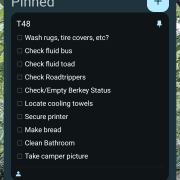
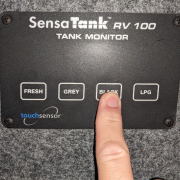
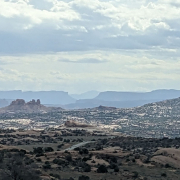 Steven V Jackson
Steven V Jackson
